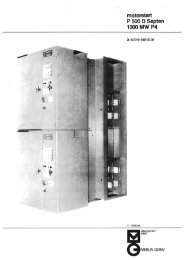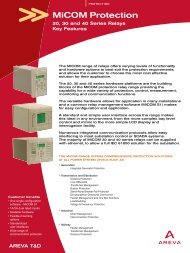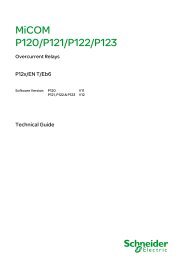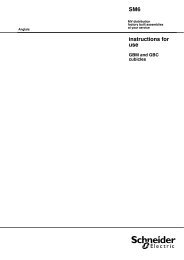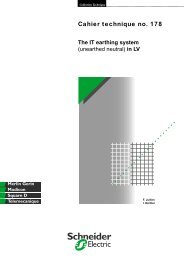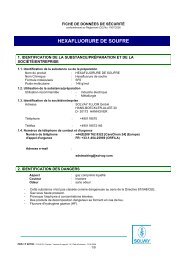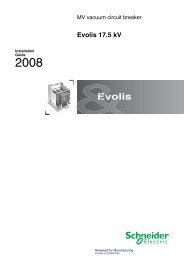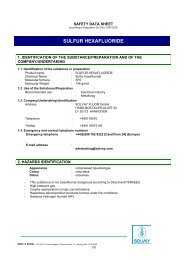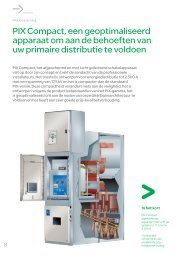- Page 1:
MiCOMP921/P922/P923Voltage and Freq
- Page 4 and 5:
P92x/EN T/H42Page 2/2Technical Guid
- Page 7 and 8:
Pxxx/EN SS/G11Safety Section Page 1
- Page 9 and 10:
Pxxx/EN SS/G11Safety Section Page 3
- Page 11 and 12:
Pxxx/EN SS/G11Safety Section Page 5
- Page 13 and 14:
Pxxx/EN SS/G11Safety Section Page 7
- Page 15:
IntroductionP92x/EN IT/H42MiCOM P92
- Page 18 and 19:
P92x/EN IT/H42Page 2/6IntroductionM
- Page 20 and 21:
P92x/EN IT/H42Page 4/6IntroductionM
- Page 22 and 23:
P92x/EN IT/H42Page 6/6IntroductionM
- Page 25 and 26:
Getting StartedP92x/EN GS/F22MiCOM
- Page 27 and 28:
Getting StartedP92x/EN GS/F22MiCOM
- Page 29 and 30:
Getting StartedP92x/EN GS/F22MiCOM
- Page 31 and 32:
Getting StartedP92x/EN GS/F22MiCOM
- Page 33 and 34:
Getting StartedP92x/EN GS/F22MiCOM
- Page 35 and 36:
Getting StartedP92x/EN GS/F22MiCOM
- Page 37 and 38:
Getting StartedP92x/EN GS/F22MiCOM
- Page 39 and 40:
Getting StartedP92x/EN GS/F22MiCOM
- Page 41 and 42:
Getting StartedP92x/EN GS/F22MiCOM
- Page 43 and 44:
Getting StartedP92x/EN GS/F22MiCOM
- Page 45 and 46:
Getting StartedP92x/EN GS/F22MiCOM
- Page 47:
Connection DiagramsP92x/EN CO/F22Mi
- Page 50 and 51:
P92x/EN CO/F22Page 2/10Connection D
- Page 52 and 53:
P92x/EN CO/F22Page 4/10Connection D
- Page 54 and 55:
P92x/EN CO/F22Page 6/10Connection D
- Page 56 and 57:
P92x/EN CO/F22Page 8/10Connection D
- Page 58 and 59:
P92x/EN CO/F22Page 10/10Connection
- Page 61 and 62:
Technical GuideP92x/EN TD/H42Techni
- Page 63 and 64:
Technical GuideP92x/EN TD/H42Techni
- Page 65 and 66:
Technical GuideP92x/EN TD/H42Techni
- Page 67 and 68: Technical GuideP92x/EN TD/H42Techni
- Page 69 and 70: Technical GuideP92x/EN TD/H42Techni
- Page 71 and 72: Technical GuideP92x/EN TD/H42Techni
- Page 73 and 74: Technical GuideP92x/EN TD/H42Techni
- Page 75 and 76: Technical GuideP92x/EN TD/H42Techni
- Page 77 and 78: Technical GuideP92x/EN TD/H42Techni
- Page 79 and 80: Technical GuideP92x/EN TD/H42Techni
- Page 81 and 82: Technical GuideP92x/EN TD/H42Techni
- Page 83 and 84: Technical GuideP92x/EN TD/H42Techni
- Page 85 and 86: Technical GuideP92x/EN TD/H42Techni
- Page 87 and 88: Technical GuideP92x/EN TD/H42Techni
- Page 89 and 90: Technical GuideP92x/EN TD/H42Techni
- Page 91 and 92: Technical GuideP92x/EN TD/H42Techni
- Page 93 and 94: Technical GuideP92x/EN TD/H42Techni
- Page 95 and 96: Technical GuideP92x/EN TD/H42Techni
- Page 97 and 98: Technical GuideP92x/EN TD/H42Techni
- Page 99 and 100: Technical GuideP92x/EN TD/H42Techni
- Page 101 and 102: Technical GuideP92x/EN TD/H42Techni
- Page 103: Technical GuideP92x/EN FT/H42MiCOM
- Page 106 and 107: P92x/EN FT/H42Page 2/70Technical Gu
- Page 108 and 109: P92x/EN FT/H42Page 4/70Technical Gu
- Page 110 and 111: P92x/EN FT/H42Page 6/70Technical Gu
- Page 112 and 113: P92x/EN FT/H42Page 8/70Technical Gu
- Page 114 and 115: P92x/EN FT/H42Page 10/70Technical G
- Page 116 and 117: P92x/EN FT/H42Page 12/70Technical G
- Page 120 and 121: P92x/EN FT/H42Page 16/70Technical G
- Page 122 and 123: P92x/EN FT/H42Page 18/70Technical G
- Page 124 and 125: P92x/EN FT/H42Page 20/70Technical G
- Page 126 and 127: P92x/EN FT/H42Page 22/70[59N] filte
- Page 128 and 129: P92x/EN FT/H42Page 24/70Technical G
- Page 130 and 131: P92x/EN FT/H42Page 26/70FREQTechnic
- Page 132 and 133: P92x/EN FT/H42Page 28/70Technical G
- Page 134 and 135: P92x/EN FT/H42Page 30/70Technical G
- Page 136 and 137: P92x/EN FT/H42Page 32/70Technical G
- Page 138 and 139: P92x/EN FT/H42Page 34/70Technical G
- Page 140 and 141: P92x/EN FT/H42Page 36/70Technical G
- Page 142 and 143: P92x/EN FT/H42Page 38/70[27] V
- Page 144 and 145: P92x/EN FT/H42Page 40/70[59] V>>=[5
- Page 146 and 147: P92x/EN FT/H42Page 42/70[59N] DELAY
- Page 148 and 149: P92x/EN FT/H42Page 44/70Technical G
- Page 150 and 151: P92x/EN FT/H42Page 46/70PROTECTION
- Page 152 and 153: P92x/EN FT/H42Page 48/70Technical G
- Page 154 and 155: P92x/EN FT/H42Page 50/70Technical G
- Page 156 and 157: P92x/EN FT/H42Page 52/70Technical G
- Page 158 and 159: P92x/EN FT/H42Page 54/70Technical G
- Page 160 and 161: P92x/EN FT/H42Page 56/70Technical G
- Page 162 and 163: P92x/EN FT/H42Page 58/70Technical G
- Page 164 and 165: P92x/EN FT/H42Page 60/70Technical G
- Page 166 and 167: P92x/EN FT/H42Page 62/70t AUX 1 =t
- Page 168 and 169:
P92x/EN FT/H42Page 64/70NB OPERATIO
- Page 170 and 171:
P92x/EN FT/H42Page 66/70Technical G
- Page 172 and 173:
P92x/EN FT/H42Page 68/70Technical G
- Page 174 and 175:
P92x/EN FT/H42Page 70/70Technical G
- Page 177 and 178:
Menu Content TablesP92x/EN HI/H42Mi
- Page 179 and 180:
Menu Content TablesP92x/EN HI/H42Mi
- Page 181 and 182:
Menu Content TablesP92x/EN HI/H42Mi
- Page 183 and 184:
Menu Content TablesP92x/EN HI/H42Mi
- Page 185 and 186:
Menu Content TablesP92x/EN HI/H42Mi
- Page 187 and 188:
Menu Content TablesP92x/EN HI/H42Mi
- Page 189 and 190:
Menu Content TablesP92x/EN HI/H42Mi
- Page 191 and 192:
Menu Content TablesP92x/EN HI/H42Mi
- Page 193:
InstallationP92X/EN IN/F22MiCOM P92
- Page 196 and 197:
P92X/EN IN/F22Page 2/12Installation
- Page 198 and 199:
P92X/EN IN/F22Page 4/12Installation
- Page 200 and 201:
P92X/EN IN/F22Page 6/12Installation
- Page 202 and 203:
P92X/EN IN/F22Page 8/12Installation
- Page 204 and 205:
P92X/EN IN/F22Page 10/12Installatio
- Page 206 and 207:
P92X/EN IN/F22Page 12/12Installatio
- Page 209 and 210:
Commissioning GuideP92x/EN CM/F22Mi
- Page 211 and 212:
Commissioning GuideP92x/EN CM/F22Mi
- Page 213 and 214:
Commissioning GuideP92x/EN CM/F22Mi
- Page 215 and 216:
Commissioning GuideP92x/EN CM/F22Mi
- Page 217 and 218:
Commissioning GuideP92x/EN CM/F22Mi
- Page 219 and 220:
Commissioning GuideP92x/EN CM/F22Mi
- Page 221 and 222:
Commissioning GuideP92x/EN CM/F22Mi
- Page 223 and 224:
Commissioning GuideP92x/EN CM/F22Mi
- Page 225 and 226:
Commissioning GuideP92x/EN CM/F22Mi
- Page 227 and 228:
Commissioning GuideP92x/EN CM/F22Mi
- Page 229 and 230:
Commissioning GuideP92x/EN CM/F22Mi
- Page 231 and 232:
Commissioning GuideP92x/EN CM/F22Mi
- Page 233 and 234:
Commissioning GuideP92x/EN CM/F22Mi
- Page 235:
Technical GuideP92x/EN RS/H42MiCOM
- Page 238 and 239:
P92x/EN RS/H42Page 2/42Technical Gu
- Page 240 and 241:
P92x/EN RS/H42Page 4/42Technical Gu
- Page 242 and 243:
P92x/EN RS/H42Page 6/42Relay 6(P922
- Page 244 and 245:
P92x/EN RS/H42Page 8/42Technical Gu
- Page 246 and 247:
P92x/EN RS/H42Page 10/42Technical G
- Page 248 and 249:
P92x/EN RS/H42Page 12/42Technical G
- Page 250 and 251:
P92x/EN RS/H42Page 14/42Technical G
- Page 252 and 253:
P92x/EN RS/H42Page 16/42Technical G
- Page 254 and 255:
P92x/EN RS/H42Page 18/42Technical G
- Page 256 and 257:
P92x/EN RS/H42Page 20/42Technical G
- Page 258 and 259:
P92x/EN RS/H42Page 22/42Technical G
- Page 260 and 261:
P92x/EN RS/H42Page 24/42Technical G
- Page 262 and 263:
P92x/EN RS/H42Page 26/42Technical G
- Page 264 and 265:
P92x/EN RS/H42Page 28/42Technical G
- Page 266 and 267:
P92x/EN RS/H42Page 30/42Technical G
- Page 268 and 269:
P92x/EN RS/H42Page 32/42Technical G
- Page 270 and 271:
P92x/EN RS/H42Page 34/42Technical G
- Page 272 and 273:
P92x/EN RS/H42Page 36/42Technical G
- Page 274 and 275:
P92x/EN RS/H42Page 38/42Technical G
- Page 276 and 277:
P92x/EN RS/H42Page 40/42Technical G
- Page 278 and 279:
P92x/EN RS/H42Page 42/42Technical G
- Page 280 and 281:
P92x/EN VH/H42Firmware and Service
- Page 282 and 283:
P92x/EN VH/H42Page 2/6Firmware and
- Page 284 and 285:
P92x/EN VH/H42Page 4/6Firmware and
- Page 286:
P92x/EN VH/H42Page 6/6Firmware and



